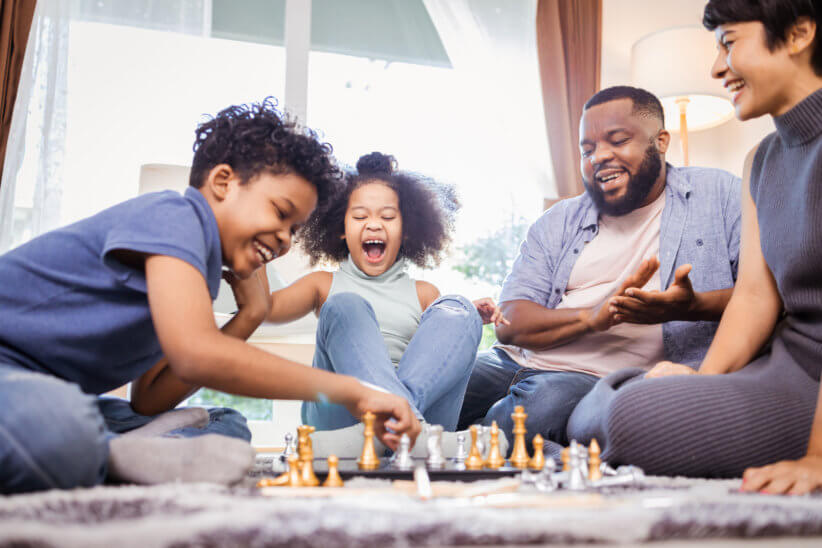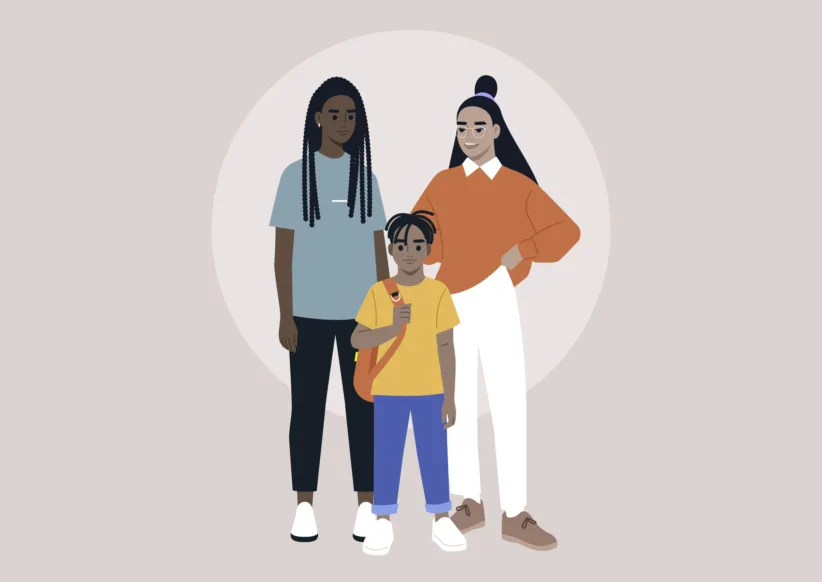My grandparents’ house was small and had only one floor. It smelled like clothes that had been hung in the back of the closet and been forgotten — worn and comfortable, remnants of a more vivacious time. My brother and I loved kneeling on the floor of my grandfather’s cluttered office and peering at the black-and-white likenesses of my parents without worry lines.
My grandmother would tell us stories about how she would harvest water chestnuts with the neighborhood kids, as we loudly slurped her hot and spicy noodle soup.
Our visits to our grandparents’ house were rare, but treasured. It was a place where we were transported to a seemingly magical past, a slower-paced life, and, of course, a place where we were spoiled rotten.
Imagine my surprise when a family friend came over, pre-teen daughter in tow, and informed me that she was having trouble getting her daughter and mother to connect.
“I feel like a telephone pole,” she said. “Without me, they’d never talk to each other.”
Her daughter, meanwhile, was texting away furiously on her cellphone, not paying us any attention. Or, maybe she was, and was relaying our entire conversation to her friends in texts. Who knows?
“All she does is text, surf the Web, or hang out with her friends. And my mother thinks I’ve failed as a mom,” my friend continued. Apparently, this was the first time grandmother and granddaughter had met since the girl was born. When the grandmother relocated closer to her family, it was like having an extra arm — awkward and disconnected.
My friend and her daughter are not alone. A 2009 Pew Research study found that 79 percent of Americans see major differences between younger and older adults in the way that they look at the world. Couple that with the fact that many grandparents live farther away from their grandchildren than before, as well as dramatic differences in culture, and the result is that many kids don’t have the same connection with their grandparents as previous generations.
But it doesn’t have to be that way. Gary Drevitch, editor-in-chief of Grandparents.com, says that there’s every reason to believe that today’s grandparents are more receptive to new technologies and connecting with youth culture.
“These are kids, now grown up, who rebelled against their parents’ culture, but, in doing so, they remade our society, permanently establishing youth culture as mainstream culture in ways that resonate today,” he says.
Both kids and grandparents can benefit from a strong and meaningful relationship. For kids, this relationship broadens their horizons. They can learn about a time different than their own, and they learn to communicate with someone who has different worldviews. Tiffany Murray, the executive director at the Macklin Intergenerational Institute, says that kids who have spent more time with older adults tend to be more accepting of classmates who differ from them.
For grandparents, spending time with younger people keeps one active — both mentally and physically. It helps them stay connected with the world and feel included.
Believe it or not, the most crucial ingredient to a strong grandchild-grandparent bond is you, the parent!
“[The parent] sets the stage. They facilitate everything,” says Amy Goyer, a grandparent expert at AARP, formerly the American Association of Retired Persons.
After my conversation with my friend, I sat down to talk to the foremost experts on intergenerational relationships — Goyer, Drevitch, Murray, and Tamar Landes from DOROT, a not-for-profit that aids homebound and homeless elders and fosters friendship between the generations. I asked them for some tips on creating that special bond, and believe it or not, it’s not that difficult.
• Create a family website. The common belief that older adults are technology averse doesn’t holds true for the boomer generation. In fact, adults 50 and older are the fastest growing demographic on Facebook and Twitter today. Grandparents are ready and willing to learn new technology, so use that to your advantage! You can also create a family website with a calendar, photos, and videos. A good place to start is familydetails.com. Webcams are a great way for face-to-face time even when grandparents live far away. Goyer says that the most important thing for a strong grandparent-grandchild relationship is time together, whether it is virtual or in real time.
• Tell bedtime stories. One thing that all grandparents have is stories — and a lot of them. No one else can tell a child who has misbehaved, “Your father did the same thing when he was a kid,” and reassure them that he will turn out alright. Grandparents assure the child that he is part of something bigger than his own nuclear family, says Drevitch. Kids especially love hearing stories about when their parents were younger.
• Have a ball. Sports are timeless. Ask Grandma or Grandpa to show your son how to pitch a baseball or play a short game of wiffle ball. Both grandparent and grandkid will get some fresh air and much-needed exercise. (If the grandparent has physical limitations, tell the child about it beforehand.)
Landes, associate executive director of community relations at DOROT, says that prepping both the child and the grandparent is one of the most important things a parent can do.
“Let them learn about the challenges of an older person, teach them about respect,” he says. “How to slow down, and how to show kindness and politeness.”
• Cook. Of course, the other universal topic is food, and who better to teach kids family recipes than a grandparent? Cooking is a great hands-on activity, and gives grandparent and grandchild a lot of quality one-on-one time.
• Start a book club. Goyer says she remembers when countless grandparents and grandkids bonded over the Harry Potter books. Set aside some time for grandparents and grandkids to read together. You could even get together other grandparents in the community and form a “Grand Book Club.” Have refreshments and alternate homes for meeting places. Talk about the books that grandparents read when they were younger, and how they are similar or different from the books today.
• Just spend time together. Any time spent together is time well spent, says Goyer. Furthermore, parents are the best role models for their kids. If you spend time with your parents or parent-in-laws, your children will naturally follow suit. Try to have an open relationship about child-rearing and respect differences in opinion.
A child’s relationship with a grandparent is one of the most valuable relationships she can have. It may take some extra effort to start, but the benefits are invaluable.
“Grandparents can be an oasis of acceptance, building self-esteem for kids as they go through changes in their appearances and the stress of middle and high school,” says Drevitch. “Absolutely no one provides unconditional love the way a grandparent does.”
Jenny Chen is a freelance writer. She has written previously for Washington Parent and Parent Connection.
RESOURCES
• Grandparents.com: This website has scores of activity ideas, from celebrating half-birthdays, to turning your house into a restaurant when the grandkids visit, to making backyard carnival games with them, to making up new holidays, to paying them to help you “clean” out the attic, while they look at old family photos and take old collectibles and heirlooms home.
• AARP.com/grandparents: This site has everything from conversation starters to booklists. It also has articles for grandparents raising grandchildren.
• Familydetails.com: You can start a free family website with a family calendar and photo and video options.
• Oovoo.com or Skype.com: These are both terrific video chatting services for long distance grandparents.
• Onetsp.com: An online recipe box where grandparents and grandkids can record recipes that they’ve tried together. Or you could make one out of old fashioned cardboard and index cards!





















